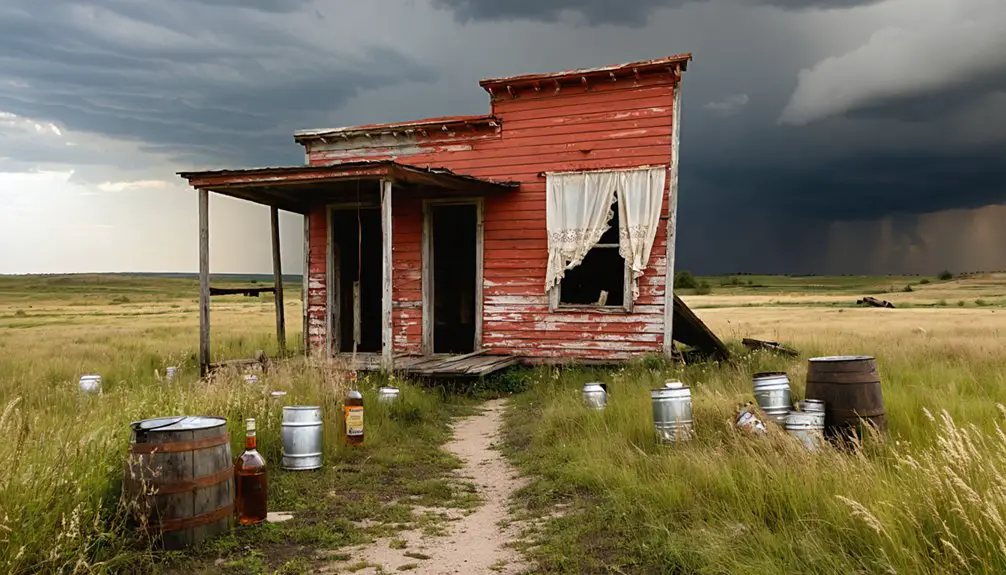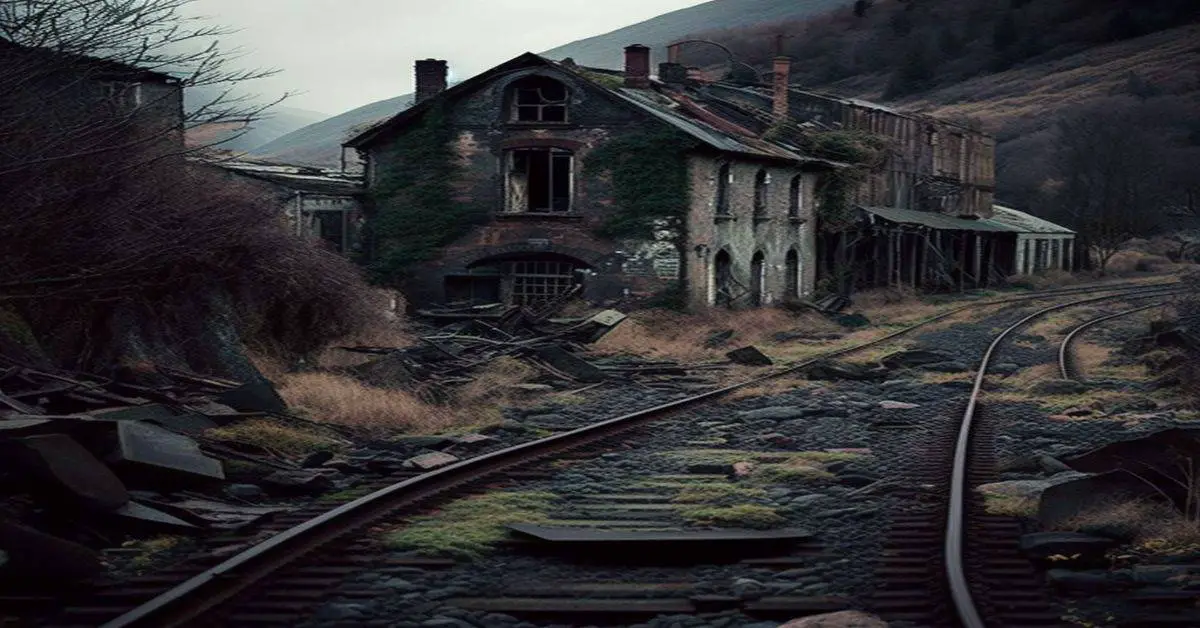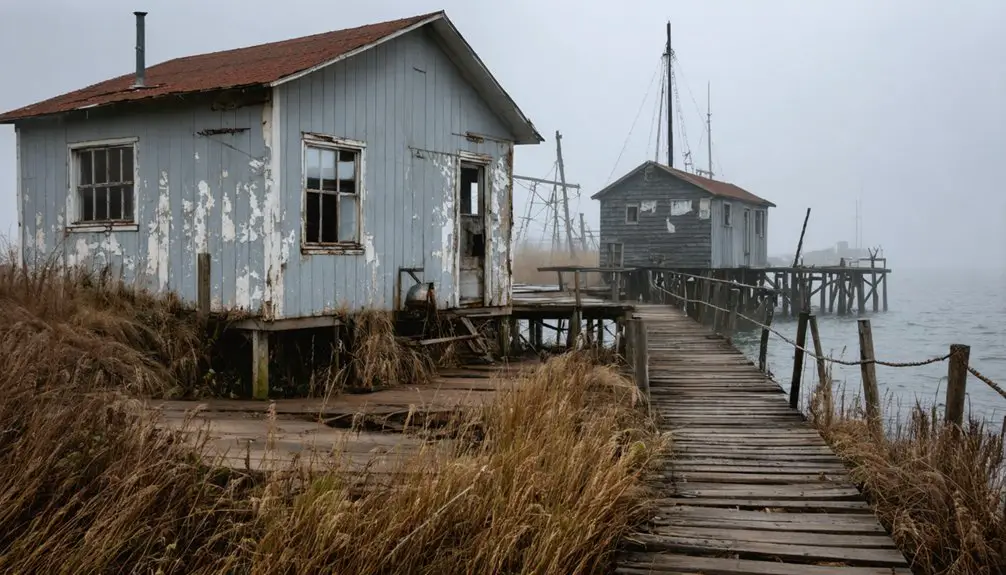You’ll discover Wisconsin’s ghost towns scattered across the state, each telling unique stories of ambition and decline. From Pendarvis’s Cornish mining settlement to the abandoned military outposts of Fort Howard and Fort Crawford, these sites showcase early settlement patterns. The logging boom towns of Emerson and Star Lake highlight the timber era, while Stonefield and Voree represent political and religious ventures. These forgotten communities offer windows into Wisconsin’s rich cultural heritage waiting to be explored.
Key Takeaways
- Pendarvis Mining Community showcases preserved limestone cottages built by Cornish miners before declining during the California Gold Rush.
- Emerson and Star Lake represent abandoned logging settlements, with Emerson’s tragic history marked by the death of four family members.
- Stonefield preserves Wisconsin’s rural heritage through 40 historic buildings and showcases early farm life from the 1900s.
- Voree, founded by James J. Strang, was a Mormon settlement of 2,000 residents that collapsed after its leader’s assassination in 1856.
- Fort Crawford and Fort Howard, once vital military outposts, now exist as partially preserved historic sites within modern Wisconsin communities.
The Rise and Fall of Pendarvis Mining Community
Three distinct waves of settlement shaped the rise of Pendarvis, a historic mining community near Mineral Point, Wisconsin.
First came the Native Americans, including Ho-Chunk and Sauk tribes, who mined the area’s lead deposits for centuries. In the 1820s, you’ll find European settlers arriving illegally before official treaties, enthusiastic to stake their claims in the mineral-rich region.
The most significant wave brought skilled Cornish miners in the mid-1800s, who transformed the landscape with their distinctive Mining Techniques and Cornish Heritage. They built sturdy limestone cottages reminiscent of their homeland and established a thriving community. The abundant galena limestone deposits provided ideal building material for their homes. Today, these restored structures are part of the Pendarvis historic complex maintained by the Wisconsin Historical Society.
Cornish miners carved their legacy into Wisconsin’s landscape, building limestone homes that echoed their distant Cornwall roots.
But by 1849, the California Gold Rush lured many away, and the eventual decline of lead and zinc mining sealed Pendarvis’s fate, though its preserved structures still tell the tale of Wisconsin’s mining heyday.
Military Posts Lost to Time: Fort Howard and Fort Crawford
As Wisconsin’s territorial borders took shape in the early 1800s, two strategic military outposts emerged to protect essential waterways and maintain peace on the frontier. Fort Howard in Green Bay and Fort Crawford near Prairie du Chien safeguarded the important Fox-Wisconsin trade route connecting Lake Michigan to the Mississippi River.
You’ll find their historical significance intertwined with early Wisconsin’s development, as soldiers maintained peace between settlers and Native Americans while helping build necessary infrastructure. By the 1940s, Fort Crawford’s buildings were repurposed to create part of the municipal pool complex.
Both forts declined by mid-century, with Fort Howard’s abandonment hastened by a devastating malaria outbreak. Today, you can explore Fort Howard’s preserved buildings at Heritage Hill State Park, where ghostly legends persist about Private Doyle’s murder in 1832. The tragic incident involved 2nd Lieutenant Amos Foster, who was shot by Doyle after visiting him during his imprisonment for drunkenness.
Fort Crawford’s remnants, once commanded by future president Zachary Taylor, have been integrated into Prairie du Chien’s modern landscape.
Logging Era Remnants: Tales of Emerson and Star Lake
While Wisconsin’s northern forests beckoned loggers in the early 1900s, few settlements embodied the boom-and-bust cycle more dramatically than Emerson and Star Lake. Founded in 1904 by the Emerson brothers near sacred Bearskull Lake, Emerson’s story intertwines logging legends with tragedy. After establishing their settlement, the brothers discovered virgin timber that would become their legacy.
You’ll find its haunting tale marked by the deaths of four Emerson family members, struck by lightning while fishing in 1908 – an event local Chippewa attributed to disturbing their sacred lands.
At Star Lake, you can trace the remnants of Edwards & Clinton Timber Company’s operations from the 1850s, where white pine harvesting once dominated the landscape. The town’s population swelled to over 600 residents during its peak logging years before economic decline set in.
Today, these ghostly encounters with the past reveal the true cost of rapid deforestation, as both settlements eventually succumbed to economic hardship and abandonment, leaving only memories and markers along Highway 182.
From Prosperity to Preservation: The Story of Stonefield
Located within Nelson Dewey State Park near Cassville, Stonefield stands as a tribute to Wisconsin’s rich agricultural heritage and political beginnings.
Originally the estate of Wisconsin’s first governor Nelson Dewey, the property faced tragedy when fire destroyed his mansion in 1873, leaving only brick walls standing.
The grand estate was once a showplace featuring extensive gardens and orchards.
Today, you’ll find Stonefield history preserved across 40 buildings that recreate rural Wisconsin farm life circa 1900.
Step back in time at Stonefield’s 40 historic buildings, where Wisconsin’s rural farm heritage lives on through authentic recreations.
The Stonefield museum complex, established in 1953, features authentic relocated structures and carefully crafted replicas.
You’ll experience living history through costumed interpreters demonstrating period trades in buildings like the blacksmith shop and general store.
The State Agricultural Museum, added in 1969, showcases an impressive collection of historic farm equipment, telling the story of Wisconsin’s evolution from basic farming to becoming America’s Dairyland.
Visitors can explore the site June through September during its seasonal operating schedule.
Forgotten Religious Settlements: Voree and Zarahemla
In the aftermath of Joseph Smith’s death, religious leader James J. Strang established Voree in 1846, declaring it a “garden of peace” for his followers who rejected Brigham Young’s leadership.
You’ll find this settlement’s remnants near Burlington, Wisconsin, where it once thrived with 2,000 residents, two newspapers, and various communal facilities.
Strangite leadership took a dramatic turn when Strang crowned himself king in 1850, wearing a red robe during his coronation ceremony.
His controversial embrace of polygamy and authoritarian style led to his assassination in 1856.
Escaped slaves and freed Black Americans found acceptance in nearby Cheyenne Valley, forming strong bonds with the Voree community.
The settlement declined as followers moved to Beaver Island, leaving behind ghost town remnants including foundation outlines, a hand-hewn sheep shed, and scattered brick homes.
The group reached peak of 500 followers during their time on Beaver Island before Strang’s death.
Today, while Voree and its sister settlement Zarahemla are largely abandoned, a Strangite meetinghouse still stands on the original property, preserving this unique chapter of Wisconsin’s religious history.
Frequently Asked Questions
Are Any Wisconsin Ghost Towns Considered Haunted by Paranormal Investigators?
You’ll find documented paranormal activity in Whitewater (“Second Salem”), St. Nazianz, and haunted locations like Wisconsin Rapids’ abandoned asylum and the northern Wisconsin boarding house, where investigators report supernatural occurrences.
Can Visitors Legally Collect Artifacts Found in These Abandoned Towns?
You can’t legally collect artifacts from abandoned towns without permission. Artifact collection laws require landowner approval and ethical considerations mean you should document and report significant finds to archaeologists.
What Survival Skills Were Essential for Early Settlers in These Communities?
Hard as nails, you’d need mastery of shelter building to survive brutal winters, plus essential farming techniques, food preservation, hunting, disease management, and resource trading with neighboring communities.
Which Ghost Towns Have the Most Intact Original Structures Still Standing?
You’ll find the best-preserved abandoned architecture at Henry Gratiot’s Home, New Diggings, and Jackson, where preservation efforts have maintained original structures. Clifton’s three church ruins also showcase remarkable structural survival.
How Did Native American Tribes Interact With These Now-Abandoned Settlements?
You’d think settlers and tribes peacefully coexisted, but tribal interactions often involved conflict over land rights, though some cultural exchanges through trade happened before tribes were forcibly displaced from these settlements.
References
- https://upnorthnewswi.com/2024/02/21/the-fascinating-stories-behind-7-wisconsin-ghost-towns/
- https://www.onlyinyourstate.com/experiences/wisconsin/ghost-towns-wi
- http://freepages.rootsweb.com/~gtusa/history/usa/wi.htm
- https://pbswisconsin.org/news-item/southern-wisconsins-ghost-towns-leave-behind-vital-stories/
- http://shunpikingtoheaven.blogspot.com/2016/05/a-wisconsin-ghost-town.html
- https://en.wikipedia.org/wiki/Pendarvis_(Mineral_Point
- https://trailsandtravel.com/pendarvis/
- https://www.portalwisconsin.org/archives/pendarvis_feature.cfm
- https://pendarvis.wisconsinhistory.org/explore/history-of-pendarvis/
- https://pendarvis.wisconsinhistory.org



